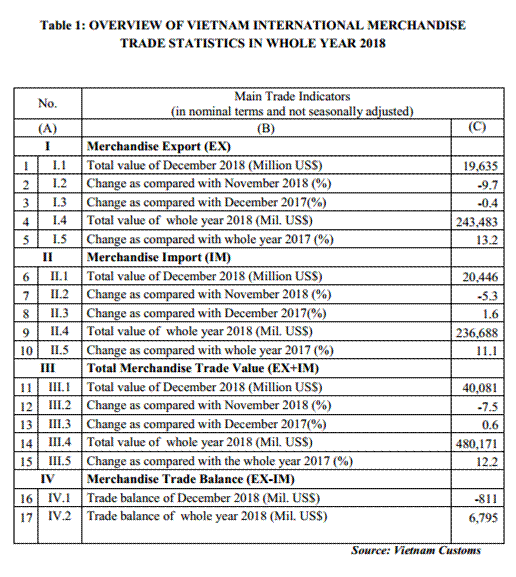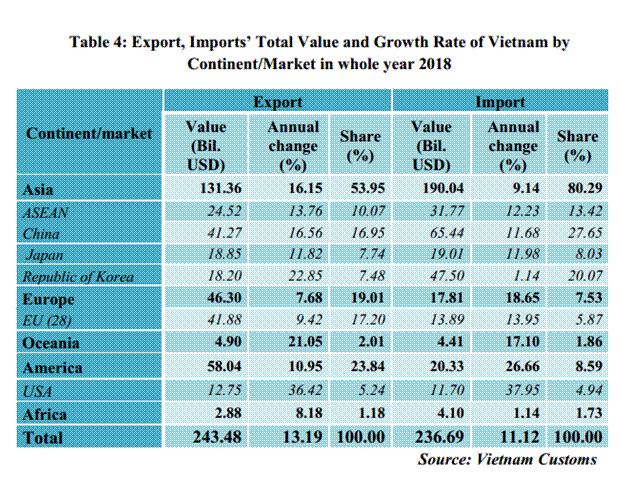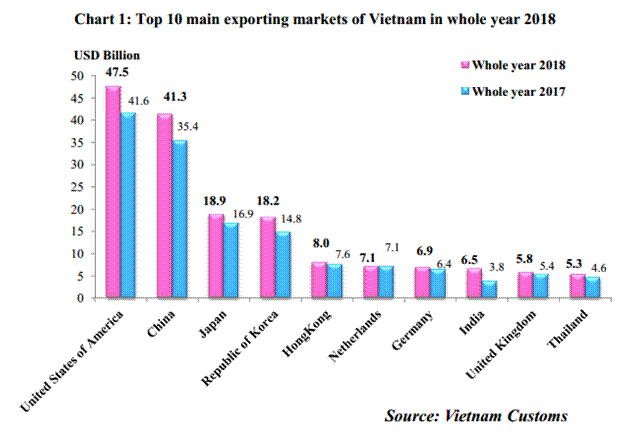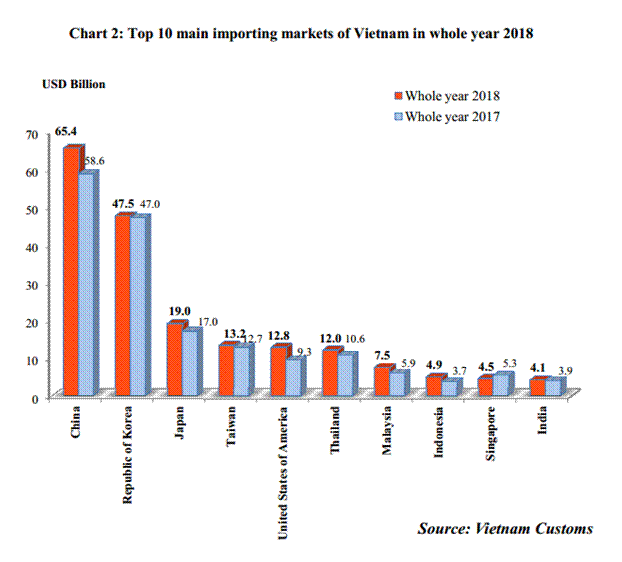Highlights of trade between Vietnam and the United States during 2010-2018 and January of 2019
Trade data compiled by General Department of Viet Nam Customs recorded a steady rise in bilateral merchandise trade between Vietnam and the United States of America (USA) during period of 2010-2018 with annual growth rate of nearly 16.4% on average. Moreover, trade-in-goods value between the two countries grew up nearly 3 times, from USD 18.01 billion recorded in 2010 to USD 60.28 billion reported for 2018.
Vietnam Customs also reported that during this period, the USA was on top three biggest trading partners of Vietnam and was the one with whom Vietnam retained the big trade surplus. For instance, in 2018, trade balance of Vietnam and the USA was in surplus for Vietnam of value USD 34.8 billion, which accounted for 73.2% Vietnam’s total export value to the USA.
According to UNCOMTRADE of United Nation Statistics Division (UNSD), trade-in-goods value of the United States for 2017 totaled USD 4191 billion. In 2017, Vietnam was ranked at 31st place amongst other exporting markets of this country and export value from the USA to Vietnam accounted for 0.5% the USA’s total export of USD 1784 billion. On import side, Vietnam took 12th place amongst other countries exporting goods to the USA with value of USD 48.4 billion, which accounted for 2.0% the USA’s total import value.
Vietnam’s main export commodities to the USA in 2018 included: textiles and garments which reached USD 13.7 billion and accounted for 28.8% total export value; foot-wears which reached USD 5.82 billion and accounted for 12.3% total export value; telephones, mobile phones and parts thereof which reached USD 5.41 billion and accounted for 11.4% total export value…
On import side: The USA was 5th trading partner exporting goods to Vietnam in 2018 with total import value of USD 12.8 billion, 36.4% above the performance of the previous year.
Vietnam’s main import commodities originated from the USA in 2018 were inclusive of: computers, electrical products and parts thereof which reached USD 3.1 billion and accounted for 24.3% total import value; cottons which reached USD 5.82 billion and accounted for 11.5% total export value; machines, equipment, tools and instrument which reached USD 1.05 billion and accounted for 8.2% total import value…
According to the latest trade data of Vietnam Customs, total merchandise trade value between Vietnam and the USA for January of 2019 went up 38.1%, to USD 6.23 billion on year-on-year basis. As compared to the corresponding period of 2018, total export value grew by 42.2%, to USD 5.15 billion and total import value expanded by 21.5%, to USD 1.08 billion.
Preliminary assessment of Vietnam international merchandise trade performance in whole year 2018
1. According to trade statistics of Vietnam Customs, in December 2018, a 7.5% downward in total external merchandise turnover of Vietnam was recorded on month-on-month basis. Exports went down 9.7%, to USD 19.64 billion and imports decreased 5.3%, to USD 20.45 billion as compared to the result of November 2018. As a result, there was a USD 811 million deficit in Vietnam’s trade balance in this month.

2. From the beginning to December of 2018, Vietnam‘s trade-in-goods totaled US dollars 480.17 billion in value terms, 12.2% above the corresponding period of last year. On year-on-year basis, total merchandise exports value rose 13.2%, to US dollars 243.48 billion and the total merchandise imports value increased 11.1% to US dollars 236.69 billion. Accordingly, Vietnam’s trade balance in whole year 2018 was in the surplus of US dollars 6.8 billion.
3. Trade data disseminated recently by Vietnam Customs announced that the total value of exportation and importation by foreign direct invested (FDI) traders reached USD 313.21 billion in total from beginning to December 2018, up by 11.7% as compared to the result of corresponding period of 2017. Total value of FDI exportation was USD 171.53 billion, went up by 12.4 %. On import side, the total value of those companies was USD 141.68 billion, went up by 10.8%.
4. On a month-on-month basis, a decrease in total merchandise exports was due to the downturns in telephones, mobile phones, parts and thereof (down by USD 1.9 billion); still image, video cameras and parts thereof (down by USD 192 million); computers, electrical products, spare-parts and components thereof (down by USD 176 million); machine, equipment, tools and instruments (down by USD 75 million)
5. On a year-on-year basis, exports expanded USD 28.36 billion. The main products, which contributed to the increase, were textiles and garments (up by USD 4.37 billion); telephones, mobile phones and parts thereof (up by USD 3.81 billion); machine, equipment, tools and instruments (up by USD 3.64 billion); computers, electrical products, spare-parts and components thereof (up by USD 3.34 billion)
6. On a month-on-month basis, a reduction in total merchandise imports value was due to the downturns of the commodities as follows: machine, equipment, tools and instruments (up by USD 306 million); telephones, mobile phones and parts thereof (up by USD 277 million); petroleum products (down by USD 130 million);
7. On a year-on-year basis, imports went up USD 23.68 billion. The growth in imports was mainly contributed by the upwards of the following products: computers, electrical products, spare-parts and components thereof (up by USD 4.42 billion); crude oil (up by USD 2.27 billion); plastics (up by USD 1.48 million).
8. In 2018, Vietnamese merchandise trade with trading partners in Asia was totaled USD 321.40 billion in value terms, which moved up 11.9% as compared to the same period of 2017. Trade-in-goods of Vietnam with America was followed, which reached USD 78.37 billion and increased by 14.6%. The values of other continents were Europe: USD 64.11 billion, up by 10.5%; Oceania: USD 9.31 billion, up by 19.1% and Africa: USD 6.98 billion, up by 3.9% in comparison with the same period of last year.

9. For January-December period of 2018, 4 importing markets of Vietnam with turnover of over USD 18 billion were: The United States of America (reached USD 47.5 billion); China (reached USD 41.3 billion); Japan (reached USD 18.9 billion); Republic of Korea (reached USD 18.2 billion)

10. According to the following chart, top 3 big sources of Vietnam’s imports were as follows: China (reached USD 65.4 billion); Republic of Korea (reached USD 47.5 billion); Japan (reached USD 19 billion).

Public tender offer on CEVA Logistics: CMA CGM becomes a world leader in transport and logistics
The Group initiated a major strategic partnership with CEVA Logistics, an important decision made by Rodolphe Saadé as part of the overall strategy of the CMA CGM Group.
On the occasion of CEVA’s initial public offering (IPO) in May 2018, CMA CGM acquired an equity stake of 24.99%, which was brought to 33% in October. CMA CGM also entered into derivative contracts between October 2018 and January 2019, enabling it to increase its economic exposure to more than 50% of CEVA’s capital.
In early 2019, CMA CGM launched a friendly Public Tender Offer on CEVA to develop a logistics offer complementary to the transport offer, allowing the Group to provide its customers end-to-end solutions.
This move represents a major transformation that will make the CMA CGM Group a world leader in both transport and logistics, with 100,000 employees and more than USD 30 billion in revenue.
ZPMC Invests in COSCO to Enhance Business with Terminal Companies
China’s crane manufacturer Shanghai Zhenhua Heavy Industries (ZPMC) has decided to invest in compatriot shipping company COSCO Shipping Holdings by acquiring CNY 419.9 million (USD 62.8 million) worth of COSCO shares.
ZPMC recently signed the share subscription agreement with COSCO Shipping Holdings for private A share of 111,111,111 at the price of CNY 3.78 for each share.
As explained, the investment is expected to further deepen collaboration between ZPMC and COSCO in the port machinery, maritime engineering as well as services and logistics.
Specifically, ZPMC intends to enhance business with various terminal companies by using COSCO’s industrial influence on terminal companies around the globe.
CMA CGM volume revenue increase in 2018
French carrier says CEVA acquisition will create $30 billion company offering door-to-door logistics.
CMA CGM Group said it had revenue of $23.5 billion in 2018, 11.2 percent more than the $21.1 billion it had in 2017. The Marseilles, France-headquartered container shipping giant had a net profit of $34 million in 2018 compared to $697 million in 2017, excluding exceptional items on non-consolidated subsidiaries including the Swiss logistics company CEVA and the containership leasing company Global Ship Lease.
CMA CGM had core earnings before interest and tax (EBIT) of $610 million in 2018, less than half the $1.58 billion core EBIT it reported in 2017. The company moved 20.7 million TEUs of containers in 2018, 9.3 percent more than in 2017. Revenue was up even more sharply in the fourth quarter of 2018 to $6.3 billion, 14.9 percent more than the $5.48 billion CMA CGM reported in the fourth quarter of 2017. CMA CGM had core earnings before interest and tax (EBIT) of $195 million in the fourth quarter of 2018, compared to $282 million in the fourth quarter of 2017. The company moved 5.32 million TEUs in the fourth quarter of 2018, 7.9 percent more than in the same 2017 period.
CMA CGM launched a tender offer for CEVA stock last month. Through the CEVA stock it owns and derivative contacts, CMA CGM said it already had “economic exposure” to more than half of CMA CGM’s equity. It said together with CEVA the two companies have created a new strategic plan that will “make the CMA CGM Group a world leader in both transport and logistics, with 100,000 employees and more than $30 billion in revenue.”
Saade said CMA CGM “will continue our development with the objective of improving profitability. That is why we are launching a new $1.2 billion cost reduction plan.” The company said the plan includes both optimizing lines and brands as well as a streamlining processes. The company already has agreed to unite its Containerships and McAndrews brands next month under the Containerships name. Another CMA CGM brand is APL.
He said CMA CGM’s current public tender offer for the logistics company CEVA is friendly and part of CMA CGM’s “ambition is to become a world leader in both transport and logistics, thereby providing a complete and efficient service offer to our customers.”
Container shipping demand to outpace supply in 2019: Yang Ming
The global container shipping market is expected to stay on a recovery course this year with demand growth predicted to outpace supply growth, according to Yang Ming Marine Transport Corp chairman Bronson Hsieh.
Despite continuing uncertainties in the global economy, Hsieh believes that the container shipping market has hit rock-bottom and prospects for this year will improve, though he remains cautiously optimistic.
Hsieh, in an interview to the Chinese media, predicts that demand growth will outpace supply growth this year, though there is a challenge of an anticipated higher bunker fuel prices.
He expects global container capacity to grow 3.2% this year while shipping demand will grow 3.8% compared to last year, allowing the market supply and demand to be more balanced and a rebound from last year. Yang Ming’s expectations of container market growth exceed those of the largest container line Maersk Line which last week forecast 1 - 3% growth for 2019.
Bunker fuel prices, however, are not expected to paint a good picture. With crude oil prices forecast to average at around $65 per barrel this year, Hsieh expects bunker fuel prices to hover around $430-440 per metric tonne (pmt), or at least below $450 pmt.
Hsieh’s estimation points to higher fuel prices this year as bunker fuel prices were recorded at an average of $400 pmt in 2018, already higher compared to $300 pmt in 2017. Yang Ming’s bottom line was hit in 2018 due to an additional $200m in bunker fuel cost over the previous year.
Despite potentially higher bunker prices, Hsieh said that as long as price volatility is kept to a minimum, the stability will allow shipping company to control its costs. Moreover, oil prices cannot go too low as that would indicate a slowing economy overall.
Hsieh recalled that 2018 had been a “difficult year” for container shipping and he is hoping that the market is passed its trough, though a strong recovery is not yet in sight.
According to Alphaliner data, the container shipping market in 2018 saw capacity growth outpaced demand growth at 5.7% and 4.4% respectively, worsening the already oversupplied market.
Looking into 2019, geopolitical uncertainties such as Brexit and the China-US trade war would impact the shipping market, Hsieh noted.
However the biggest impact on the shipping market would be the upcoming IMO 2020 fuel Sulphur cap regulation. Ship owners largely can opt to directly burn the 0.5% compliant fuel or install scrubbers so as to continue using 3.5% Sulphur content fuel. Hsieh said that no matter which method of compliance a shipping company chooses, operating cost is bound to increase.
The upside of the impact of the IMO regulation is that capacity supply is expected to deflate at a quicker pace as those less energy efficient elderly vessels would be forced to exit the market sooner, he said.
Ultimately, whether a shipping company can make profit has always been closely linked to market supply and demand, and from this perspective Hsieh believes that this year presents a more optimistic scenario.
But he also pointed out that supply and demand will keep changing in line with market developments, and his prediction is as good as anybody’s guess.
Souce: World Maritime News, CMA-CGM Website, Vietnam Custom, Sea Trade Maritime

.png)






.jpg)


